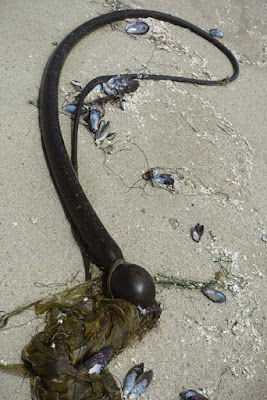 |
| McClure's Beach, Point Reyes National Seashore, California |
In mid-August Art and I spent a day at Point Reyes National Seashore and I wrote the report below. A week later, wildfires broke out all around the greater Bay Area, including the Woodward fire in the southern part of the National Seashore. If you are planning a trip to the area, be sure to check the National Park website to find out which areas may be closed.
For a change of scenery from our house in Oakland we did an expedition last week to
Point Reyes National Seashore in Marin County and hiked down to McClure's beach, the northernmost beach on the Pacific side of the long peninsula. It was the perfect Covid destination, with so much room for social distancing that we could barely see the few other people who were there. (We did our trip on a weekday–which also helped reduce the number of people.) It was also the perfect choice temperature-wise on a warm summer day--not too cold and not too hot.
 |
| Near the end of the trail to McClure's Beach. |
It had been a long time since we've been to Point Reyes, and my memory is that it can be windy and cold, and that is certainly true in winter. It can also be enshrouded in fog. But we were lucky and
visited on a warm August day, perfect for a picnic and walk on the beach.
Point Reyes is a long peninsula, about an hour’s drive north of the San Francisco Bay area. The west side faces the Pacific Ocean, where heavy surf pounds the shore underneath steep cliffs. The east side faces much calmer Tomales Bay, a narrow strip of water dividing Point Reyes from the mainland. The south facing part of the peninsula is on
Drake’s Bay, named after the English explorer Sir Francis Drake, who is believed to have landed there on his trip around the world in 1579.
 |
| Pierce Point Ranch with Tomales Bay to the East |
We drove from Oakland across the Richmond Bridge to San Rafael and then through beautiful rural Marin County. At first the landscape is rolling farmland, but then the road passes through stands of gorgeous redwoods before emerging near the coast. We entered Point Reyes National Seashore just south of the town of Point Reyes Station, driving along Francis Drake Boulevard. After passing through the small town of Inverness, we came to a choice point–left, the road to the lighthouse (now partially closed), or right to the northern beaches and Historic Pierce Point Ranch.
 |
| Historical marker at Pierce Point Ranch. The ranch was established in the 1820s by James Berry, a Mexican citizen, who lost it in a land dispute after California became a state. In 1858, the land was sold to the Pierce family. |
We went to the right, drove to the end of the road and parked in the shade of giant eucalyptus trees planted by early settlers. There we had another choice point–a hiking trail to McClure’s beach, or another trail along the top of the ridge to the end of the peninsula. We chose the former, a .4 mile path that follows a narrow stream to the bottom of the cliff and the wide expanse of the beach.
 |
| Trail to the beach is .4 miles down a sandy path. |
 |
| At the end of the trail, flowers bloom along the edge of a shallow pond at the base of the cliff. |
 |
| Walking north on McClure's Beach |
After eating our sandwiches in the shade of the cliff, we took a walk along the shore. The tide was out, leaving a band of empty mussel shells, kelp, jelly fish and random feathers along the tide line.
 |
| Kelp and mussel shells |
 |
| Jellyfish |
Historically settled by ranchers, the open grasslands of Point Reyes are still used for grazing cattle, although the ranches are now managed by the National Park Service. The northern tip of Point Reyes is a designated refuge for Tule Elk, a native Californian elk, similar to Rocky Mountain elk but smaller, and once in danger of extinction.
 |
| The last curve of the road before arriving at Pierce Point Ranch. At the top of the photo, the white spot is Bird Rock, located just off Tomales Point, the extreme northern tip of Point Reyes. |
On our way back up the trail we spotted a herd of elk grazing on a hillside near the road. As we drove out we stopped to get a closer look and take a picture of the elk, but they were too far away. After we got home I realized that a tiny spot in one of my pictures was actually an elk.
There are many options for
hikes at Point Reyes. We plan to go back in the future and try some of the other trails.
Map: Click
HERE for a map of Point Reyes.
Note: The Point Reyes visitor centers are currently closed, as are some of the trails and roads. Be sure to consult the
Point Reyes National Park website for current information.
As of September 23, the area and all trails south of Limantour Road and Bear Valley Road,
west of Highway 1 (aka Shoreline Highway), and north of Stewart Trail
are closed to all visitor access until further notice.
















































